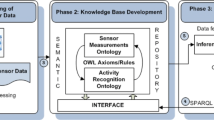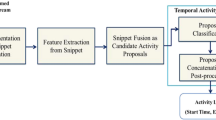Abstract
Data segmentation plays a critical role in performing human activity recognition in the ambient assistant living systems. It is particularly important for complex activity recognition when the events occur in short bursts with attributes of multiple sub-tasks. Although substantial efforts have been made in segmenting the real-time sensor data stream such as static/dynamic window sizing approaches, little has been explored to exploit object semantic for discerning sensor data into multiple threads of activity of daily living. This paper proposes a semantic-based approach for segmenting sensor data series using ontologies to perform terminology box and assertion box reasoning, along with logical rules to infer whether the incoming sensor event is related to a given sequences of the activity. The proposed approach is illustrated using a use-case scenario which conducts semantic segmentation of a real-time sensor data stream to recognise an elderly persons complex activities.











Similar content being viewed by others
References
Awan MA, Guangbin Z, Kim S-D (2012) Activity recognition in WSN: A data-driven approach. Computing and Convergence Technology (ICCCT), 2012 7th International Conference on IEEE
Azkune G, Almeida A, Lpez-de-Ipia D, Chen L (2015) Extending knowledge-driven activity models through data-driven learning techniques. Expert Syst Appl 42(6):3115–3128. doi:10.1016/j.eswa.2014.11.063
BakhshandehAbkenar A, Loke SW (2014) MyActivity: cloud-hosted continuous activity recognition using ontology-based stream reasoning. In: MOBILECLOUD '14 Proceedings of the 2014 2nd IEEE International Conference on Mobile Cloud Computing, Services, and Engineering, pp 117–126. doi:10.1109/MobileCloud.2014.27
Balduini M, Della Valle E, DellAglio D, Tsytsarau M, Palpanas T, Confalonieri C (2013) Social listening of city scale events using the streaming linked data framework. In: ISWC '13 Proceedings of the 12th International Semantic Web Conference - Part II 8219:1–16. doi:10.1007/978-3-642-41338-4_1
Barnaghi P, Wang W, Dong L, Wang C (2013) A linked-data model for semantic sensor streams. In: GREENCOM-ITHINGS-CPSCOM '13 Proceedings of the 2013 IEEE International Conference on Green Computing and Communications and IEEE Internet of Things and IEEE Cyber, Physical and Social Computing, pp 468–475. doi:10.1109/GreenCom-iThings-CPSCom.95
Calbimonte J, Jeung H, Corcho O, Aberer K (2011) Semantic sensor data search in a large-scale federated sensor network. Semant Sens Netw 839:23–38
Chen L, Hoey J, Nugent CD, Cook DJ, Yu Z (2012) Sensor-based activity recognition. IEEE Trans Syst Man Cybern Part C Appl Rev 42:790–808. doi:10.1109/TSMCC.2012.2198883
Chen L, Nugent CD, Wang H (2012) A knowledge-driven approach to activity recognition in smart homes. IEEE Trans Knowl Data Eng 24:961–974. doi:10.1109/TKDE.2011.51
Chen L, Nugent C, Okeyo G (2014) An ontology-based hybrid approach to activity modeling for smart homes. IEEE Trans Hum Mach Syst 44:92–105. doi:10.1109/THMS.2013.2293714
Cook D, Feuz K, Krishnan N (2013) Transfer learning for activity recognition: a survey. Knowl Inf Syst 36:537–556. doi:10.1007/s10115-013-0665-3
Ferroni G, Bonfigli R, Principi E, Squartini S, Piazza F (2015) A deep neural network approach for voice activity detection in multi-room domestic scenarios. Neural Netw. doi:10.1109/IJCNN.2015.7280510
Fobel A, Subramanian N (2016) Comparison of the performance of Drools and Jena rule-based systems for event processing on the semantic web. In: 2016 IEEE/ACIS 14th international conference on software engineering, research, management and applications SERA 2016, pp 24–30. doi:10.1109/SERA.2016.7516153
Ganz F, Barnaghi P, Carrez F (2014) Acquis From Sens Data 10:1–12
Gu T, Wang L, Wu Z, Tao X, Lu J (2011) A pattern mining approach to sensor-based human activity recognition. IEEE Trans Knowl Data Eng 23:1359–1372. doi:10.1109/TKDE.2010.184
Hu DH, Yang Q (2008) CIGAR: concurrent and interleaving goal and activity recognition. In: AAAI conference on artificial intelligence, pp 1363–1368
Huang V, Javed MK (2008) Semantic sensor information description and processing. In: Proc-2nd Int Conf Sens Technol Appl, SENSORCOMM 2008, Incl MESH 2008 Conf Mesh Networks; ENOPT 2008 Energy Optim Wirel Sensors Networks, UNWAT 2008 Under Water Sensors Syst, pp 456–461. doi:10.1109/SENSORCOMM.2008.23
Kang H, Hebert M, Efros AA, Kanade T (2015) Data-driven objectness input image database of object regions high objectness regions. IEEE Trans Pattern Anal Mach Intell 37:189–195
Khan JA, Kumar S (2015) OWL, RDF, RDFS inference derivation using Jena semantic framework and pellet reasoner. In: 2014 international conference on advances in engineering and technology research ICAETR 2014, p 07. doi:10.1109/ICAETR.2014.7012871
Kharlamov E, Kotidis Y, Mailis T, Neuenstadt C, Nikolaou C, zcep,Svingos C, Zheleznyakov D, Lamparter S, Horrocks I, Ioannidis Y, Mller R (2016) Towards analytics aware ontology based access to static and streaming data (extended version), p 122. doi:10.1007/978-3-319-46547-0
Kuka C, Nicklas D (2014) Enriching sensor data processing with quality semantics. In: PERCOM Work 2014 IEEE international conference on pervasive computing and communication workshops, pp 437–442. doi:10.1109/PerComW.2014.6815246
Liu Y, Nie L, Liu L, Rosenblum DS (2015) From action to activity: sensor-based activity recognition. Neurocomputing. doi:10.1016/j.neucom.2015.08.096
Okeyo G, Chen L, Wang H (2014) Combining ontological and temporal formalisms for composite activity modelling and recognition in smart homes. Futur Gener Comput Syst 39:29–43. doi:10.1016/j.future.2014.02.014
Okeyo G, Chen L, Wang H, Sterritt R (2014) Dynamic sensor data segmentation for real time activity recognition. Pervasive Mob Comput 10(1):155–172
Okeyo G, Chen L, Wang H, Sterritt R (2014) Dynamic sensor data segmentation for real-time knowledge-driven activity recognition. Pervasive Mob Comput 10:155–172. doi:10.1016/j.pmcj.2012.11.004
Ramar K, Mirnalinee TT (2012) An ontological representation for Tsunami early warning system. In: Advances in engineering, science and management (ICAESM), 2012 international conference on IEEE, pp 93–98
Riboni D, Bettini C (2011) OWL 2 modeling and reasoning with complex human activities. Pervasive Mob Comput 7:379–395. doi:10.1016/j.pmcj.2011.02.001
Snchez D, Tentori M, Favela J (2008) Activity recognition for the smart hospital. IEEE Intell Syst 23:50–57. doi:10.1109/MIS.2008.18
Triboan D, Chen L, Chen F (2016) Towards a mobile assistive system using service- oriented architecture. In (2016) IEEE Symp. Syst. Eng. Towar. IEEE, Oxford, Serv, pp 187–196
Triboan D, Chen L, Chen F, Wang Z (2016) Towards a service-oriented architecture for a mobile assistive system with real-time environmental sensing. Tsinghua Sci Technol 21:581–597
Valle ED, Grossniklaus M (2010) C-SPARQL: a continuous query language for rdf data streams. Int J Semant Comput 4:3–25
W3C (2004) SWRL: a semantic web rule language combining OWL and RuleML. https://www.w3.org/Submission/SWRL/. Accessed 20 Aug 2016
W3C (2005) Semantic sensor network ontology. https://www.w3.org/2005/Incubator/ssn/ssnx/ssn. Accessed 1 Oct 2016
W3C (2011) SPIN-overview and motivation. https://www.w3.org/Submission/spin-overview/. Accessed 22 Aug 2016
W3C (2014) RDF stream processors implementation-rdf stream processing community group. https://www.w3.org/community/rsp/wiki/RDF_Stream_Processors_Implementation. Accessed 5 Oct 2016
Wan J, OGrady MJ, OHare GMP (2015) Dynamic sensor event segmentation for real-time activity recognition in a smart home context. Pers Ubiquitous Comput 19:287301. doi:10.1007/s00779-014-0824-x
Wei W, Barnaghi P (2009) Semantic annotation and reasoning for sensor data. In: Barnaghi P, Moessner K, Presser M, Meissner S (eds) Lect. Notes Comput. Sci. Springer, Berlin, pp 66–76
Ye J, Stevenson G, Dobson S (2014) USMART: an unsupervised semantic mining activity recognition technique. In: ACM transactions on intelligent systems, pp 4:16–116:27. doi:10.1145/2662870
Ye J, Stevenson G, Dobson S (2014) KCAR: a knowledge-driven approach for concurrent activity recognition. Pervasive Mob Comput 19:4770. doi:10.1016/j.pmcj.2014.02.003
Zhang S, Guo J, Yu Z, Lei C, Mao C, Wang H (2010) An approach of domain ontology construction based on resource model and Jena. In: 2010 third international symposium on information processing, pp 311–315. doi:10.1109/ISIP.2010.44
Zhang W, Duan L, Chen J (2010) Reasoning and realization based on ontology model and Jena. In: proceedings of the 2010 IEEE 5th international conference on bio-inspired computing: theories and applications BIC-TA 2010, pp 1057–1060. doi:10.1109/BICTA.2010.5645115
Zep L, Mller R, Neuenstadt C (2014) A stream-temporal query language for ontology based data access. KI 2014 Adv Artif Intell, pp 183–194. doi:10.1007/978-3-319-11206-0_18
Author information
Authors and Affiliations
Corresponding author
Rights and permissions
About this article
Cite this article
Triboan, D., Chen, L., Chen, F. et al. Semantic segmentation of real-time sensor data stream for complex activity recognition. Pers Ubiquit Comput 21, 411–425 (2017). https://doi.org/10.1007/s00779-017-1005-5
Received:
Accepted:
Published:
Issue Date:
DOI: https://doi.org/10.1007/s00779-017-1005-5




